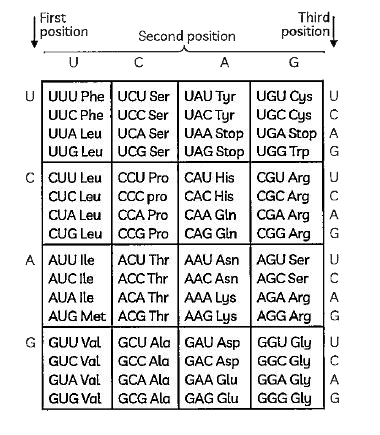Observe the given figure and identify the incorrect statement:

(I) The genetic code is degenerate.
(II) AUG serves dual functions.
(III) The genetic code is nearly universal with not exceptions.
(IV) The genetic code is non-ambiguous and specific which means a specific codon will only code for a particular amino acid.
A
(I),(II)
B
(III)
C
(II)
D
(III),(IV)
Text Solution
The correct Answer is:B
The genetic code is nearly universal. This means that a particular codon codes for the same amino acid in all the organisms except in mitochondrial codons, and in some protozoans.
|
Topper's Solved these Questions
Similar Questions
Knowledge Check
Assertion. The genetic code is degenerate.
Reason. Most amino acids are coded by more than one codon.AIf both A and R are true and R is the correct explanation of ABIf both A and R are true but R is not the correct explanation of ACIf A is true and R is falseDIf both A and R are falseAssertion :- Genetic codes are unambigous & specific.
Reason : Some amino acids are coded by more than one codon.AIf both Assertion & Reason are True & the Reason is a correct explanation of the Assertion.BIf both Assertion & Reason are trur but Reason is not a correct explanation of the Assertion.CIf Assertion is True but the Reason is Flase.DIf both Assertion & Reason are false.Which is incorrect for genetic code?
(i) The codon is triplet
(ii) 64 codons code for amino acids
(iii) Genetic code is unambigous
(iv) Genetic code is nearlyuniversal
(v) Genetic code dual functionsAonly (ii)B(ii) & (iii)C(iii), (iv), (v)DAll are correct
Assertion :- Genetic codes are unambigous & specific.
Reason : Some amino acids are coded by more than one codon.
View SolutionSome amino acids are coded by more than one codon, hence the genetic code is
View SolutionSome amino acids are coded by more than one codon, hence the genetic code is
View SolutionThe genetic code is
I. Universal
II. Commaless
III. Degenerate
IV. Ambiguous
View SolutionAssertion. The genetic code is degenerate.
Reason. Most amino acids are coded by more than one codon.
View Solution
